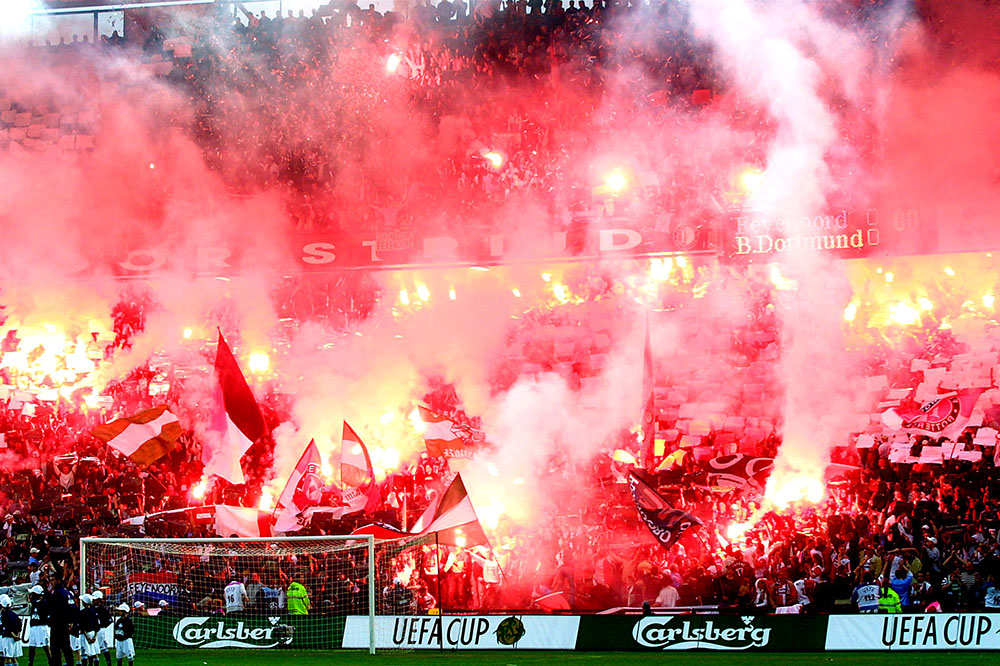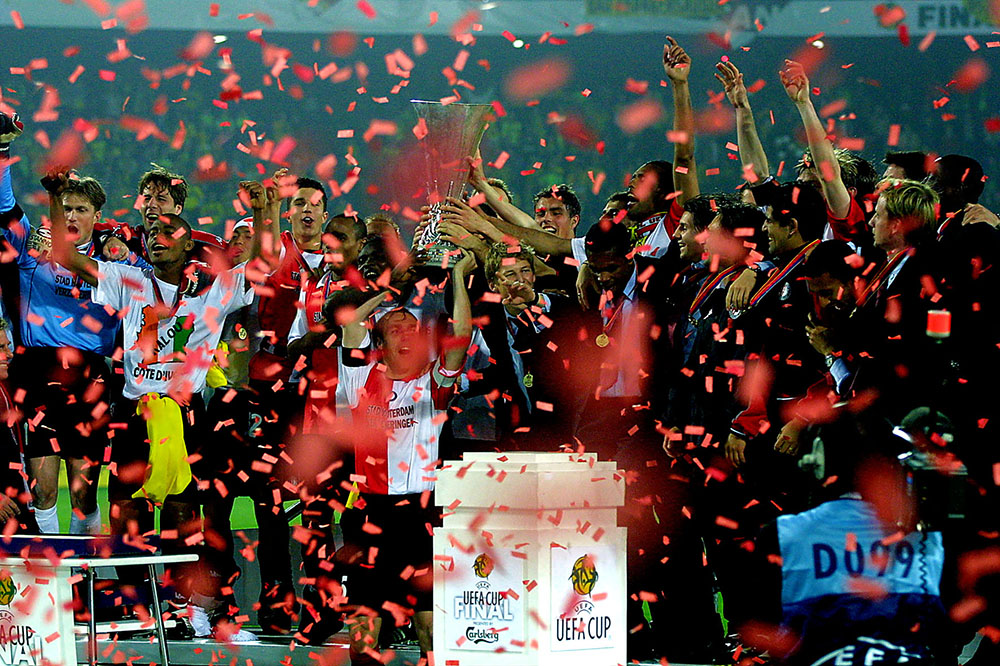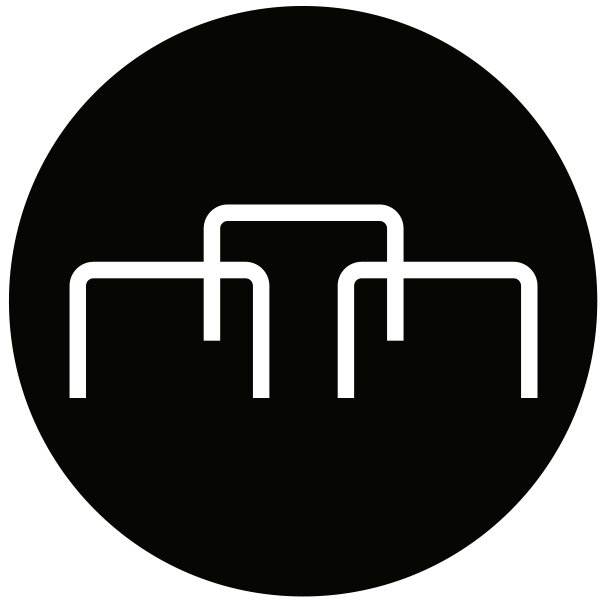It was the Netherlands’ 9/11: everyone remembers it and everyone remembers what they were doing that ordinary Monday afternoon in May, 2002. Bert van Marwijk remembers it, Pierre van Hooijdonk remembers it and so do Joost de Jong and Ivo Opstelten, the then-mayor and member of the conservative-liberal party VVD, Volkspartij voor Vrijheid en Democratie.
The coach was at a hotel, the striker on the way home from training, the mayor in a meeting and the reporter De Jong researching a story. With shock, they learned the news: the far-right politician Pim Fortuyn had been assassinated. That morning, Fortuyn had visited De Kuip, the venue for the UEFA Cup final between Feyenoord and Borussia Dortmund two days later. Fortuyn wasn’t exactly a big fan of football.
Drunk supporters
In 1996 he had navigated his way home among drunk Dutch and German supporters. Immaculately dressed, briefcase in hand, he frowned at all the adults and their orange paraphernalia. Why all the fuss about a leather ball? For many years, the Randweg was a safe space overlooking Hillesluis, one of Rotterdam’s poorest neighbourhoods. Fortuyn was an anomaly in the Randweg. He taught sociology at the university and was fond of cigars, wine, suits and expensive cars.
The local kids fawned over his Bentley. In Hillesluis poverty, unemployment and petty crime reigned. But it allowed Fortuyn to observe the raw tapestry of the local underclass. Fortuyn articulated what workers in the deprived areas of the city felt. He offered them hope when criticising the political establishment with outspoken opinions on integration and crime. He called Islam “retarded”. Opponents branded him a right-wing agitator.
Populist
“They said he was a populist,” said Opstelten. “He was an intellectual. He wrote a lot. His weekly column in Elsevier was widely read and he identified things with which a lot of people agreed. For example, the issue of safety in the city and the country.” Van Marwijk didn’t vote for Fortuyn, but also didn’t see in him a far-right politician. Van Hooijdonk echoes his coach’s view: “Fortuyn was so popular that he was at the point of becoming prime minister,” Van Hooijdonk said. “He had very clear ideas.”
Then, at 6.05 pm that Monday, 6 May 2002, in the car park of Hilversum’s Media Park, Volkert van der Graaf, an environmental and animal rights activist, emerged from a thicket and shot Fortuyn multiple times from close range. In his office, Opstelten first verified the news. Information was fragmented, but by the time Fortuyn passed away, the magnitude of his death could not be overstated. It was the first political murder in the contemporary history of the Netherlands.
“That’s the biggest shock you can get in a democracy when a directly elected representative is shot dead,” said Opstelten.
Emotions
Emotions stirred across Rotterdam and the Netherlands. In The Hague, the Binnenhof, where the prime minister’s office is located, required police protection. Hillesluis emptied. Fortuyn’s voters and sympathisers had been ignored and ridiculed. The marginalised were angered and dismayed. And now, even their hope had been taken away. Opstelten organised a condolence register at the town hall.
Rotterdammers, Feyenoord fans, immigrants and people from all walks of life clamoured to bid Fortuyn farewell. A large banner read: “Pim, you were murdered. But your ideas weren’t.” Nearby, a column
displayed the words attributed to Voltaire: “I disapprove of what you say, but I will defend to the death your right to say it.”
The spirit of Fortuyn
Suddenly, the UEFA Cup final felt irrelevant. As a mix of consternation, anger, anxiety and sadness descended over Rotterdam, the mayor, the police and the public prosecutor convened and determined, without pressure from UEFA – according to Opstelten – that the final would go ahead. “The match had to be played because that was in the spirit of Fortuyn as well,” explained Opstelten.
Opstelten asked UEFA for a minute of silence before kick-off, black armbands and zero tolerance for inflammatory chants in the stands. He outlawed any festivities at the Coolsingel, the beating heart of Rotterdam’s city centre and backdrop to all of Feyenoord’s historic victory parades.
Obsessed with the cup
At the pre-match news conference, journalists bombarded both Van Marwijk and Van Hooijdonk with questions about Fortuyn, much to the dismay of UEFA’s media officer. It was an unprecedented situation and Van Marwijk said as much: “I am not sure what to do with it.”
Fortuyn would have wanted us to play
“We also spoke to the team about it; how did they view it?” Van Marwijk recalled. “In the end, the general consensus was that Fortuyn would have wanted us to play. That filtered through to the club and the team.” Van Hooijdonk and the players were obsessed with the cup. “It is very easy to reply in a politically correct manner, but as a player you live in a selfish cocoon,” said Van Hooijdonk. “You think, there is nothing more important than the final.”
Strange atmosphere at De Kuip
Once at De Kuip, some sense of relief and reassurance set in. “There was a very strange atmosphere before the game,” remembered Van Marwijk. “You noticed and felt it during the warm-up, but when the referee blew for the kick-off the timidity vanished and it turned into a real final.”

A few days earlier, Van Marwijk had watched Dortmund clinch the Bundesliga title against Werder Bremen. Matthias Sammer’s side were formidable with a mix of German stalwarts and Brazilian talents, but what struck Van Marwijk most was Dortmund’s ‘organised chaos’, as he describes it. “It was a very difficult team to analyse because they actually really moved all over the field, except for the goalkeeper, the central defenders and [Stefan] Reuter, a holding midfielder,” he said. “They all stuck to their positions.
The rest just moved! It was very important to play such a team without the temptation of getting dragged out of position. You have to learn to defend the spaces, except not like 30 years ago when zonal marking arrived, without any pressure on the ball. We defended the spaces, but pressured the ball whenever possible.”
Bert van Marwijk
A young coach with credentials from his time at Fortuna Sittard, Van Marwijk had built a solid team, somewhat in the blue-collar ethos of the club. Feyenoord and Rotterdam, where the masses laboured in the port, had never had the time for the extravagance or artistry from the capital Amsterdam – urbane, distinguished, extravagant, and, above all, home to the balletic Cruijff, the mercurial number fourteen and disciple of Rinus Michels, the godfather of totaalvoetbal.
Van Hooijdonk recalled that Feyenoord had little business in the UEFA Cup, but Van Marwijk sees it somewhat differently: Feyenoord never assembled the best players, but his team gelled. Van onderen and Patrick Paauwe anchored the backline. As former midfielders, they were assets in Feyenoord’s build-up play. In midfield, the captain was the engine, whose water-carrying attitude embodied the quintessential Feyenoord player. Up front, Van Hooijdonk had to deliver goals.
Van Marwijk also singled out both Shinji Ono and Jon Dahl Tomasson for praise. “Ono played alongside Bosvelt,” he said. “He was a very good Japanese player, who acclimatised very quickly and became a fan favourite. Very creative and very skilful.
Squad
He also chipped in defensively. Paul and he were two number sixes, but Ono was also the connection with the attack. They could both score a goal. Tomasson was a shuttling player at number ten. Jon Dahl was so important to the team — he ensured that we pressed. Bosvelt and Ono dared to defend higher than their opponent, which meant that your backline moved higher. We would press with our 4-4-2 system, but in possession, Tomasson would often play higher than our striker Van Hooijdonk. When we got dispossessed, he tracked back lightning-quick.”
Against Dortmund, Feyenoord took the lead after Jürgen Kohler gave away a penalty and was sent off in the final game of his distinguished career. Van Hooijdonk stepped forward for what many consider the defining few minutes of his career. He converted the penalty. The fans yelled. “Puje——ens——-ufopierre!!!” Minutes earlier, Feyenoord’s number nine had struck the woodwork from a set piece. Van Marwijk knew what was about to happen when Van Hooijdonk got a second chance.
Free kicks
“I said to Mario Been and John Metgod, my assistants: ‘This one is going to go in because Lehmann was positioned in the same spot, a little past the centre of the goal,’” he said. “I knew immediately this was going to be a goal. If he took three free kicks and missed the first two, there was almost a guarantee that the third one would go in.”
Van Hooijdonk considers the conversion rate the true hallmark of a free-kick specialist. “Cristiano Ronaldo scored a free kick at Juventus and that was his first free-kick goal in 42 free kicks,” said Van Hooijdonk. “It is not the number that matters, but the ratio to the number of games and the number of attempts. Ronaldo is still labelled as a free-kick specialist, and yet he is not alone.”
In De Kuip, Van Hooijdonk stood at 90 degrees next to the ball, rather than behind it. He took a few loping, almost gazelle-like strides before he struck the ball with his instep. With impeccable accuracy, the ball whizzed past Jens Lehmann. Van Hooijdonk, lifting his shirt, wheeled away in celebration. The fans bellowed: “Puje—ens—ufopierre!!!” Badly positioned, the German keeper had been too late to prevent the goal.
Van Hooijdonk
He should have known better. Speed always accompanied Van Hooijdonk’s accuracy. It’s what set him apart from other set-piece specialists. Van Marwijk describes his free-kicks as a mix of Wim van Hanegem, Kristen Nygaard and Kees Kist because he combined power, refinement and curve. “Van Hooijdonk united all three,” said Van Marwijk. ‘Pierre was an autodidact.’
2-0 up, facing opponents who were down to 10 men, Feyenoord should have been home and dry. Instead, they were overwhelmed for much of the second half. Dortmund’s game gravitated towards their young Czech midfielder Tomáš Rosický with Dedé providing attacking impetus from the wing, Jan Koller dropping deep from his number nine position and Lars Ricken drifting inside. A Márcio Amoroso penalty cut the deficit before Jon Dahl Tomasson restored Feyenoord’s two-goal lead.
Put Your Hands Up For Pierre
But, even though they were trailing 3-1, Dortmund were quicker and more alert than their hosts. Koller scored to make it 3-2. Dortmund went on the attack. But Feyenoord held on for a famous victory.
Van Hooijdonk had transcended himself that night. It was only on the way home, in the car, with my mum at the wheel of our vintage Audi 100, and with the radio on, that I understood the song the local fans had belted out all night long: “Put Your Hands Up For Pierre.”
Indeed, Feyenoord had a new hero, and the city and the country a martyr they would never forget.

Uit: The Blizzard Football Magazine #50
The Blizzard 50: korting!
Onze vrienden van The Blizzard Football Magazine vieren – net als Staantribune – hun vijftigste editie! Een voorproefje uit de jongste editie van dit gerenommeerde Britse magazine, over de UEFA Cup-winst van Feyenoord in 2002, lees je hierboven. Bovendien krijgen lezers en volgers van Staantribune korting in de webshop van The Blizzard. Je betaalt £3 minder op een exemplaar van de fysieke The Blizzard Issue Fifty (print) met de volgende code: Staan3
Als je kiest voor de digitale editie van The Blizzard Issue Fifty gaat er in de webshop £1 af met de volgende code: Staan1
Foto’s: Pro Shots/Stanley Gontha



